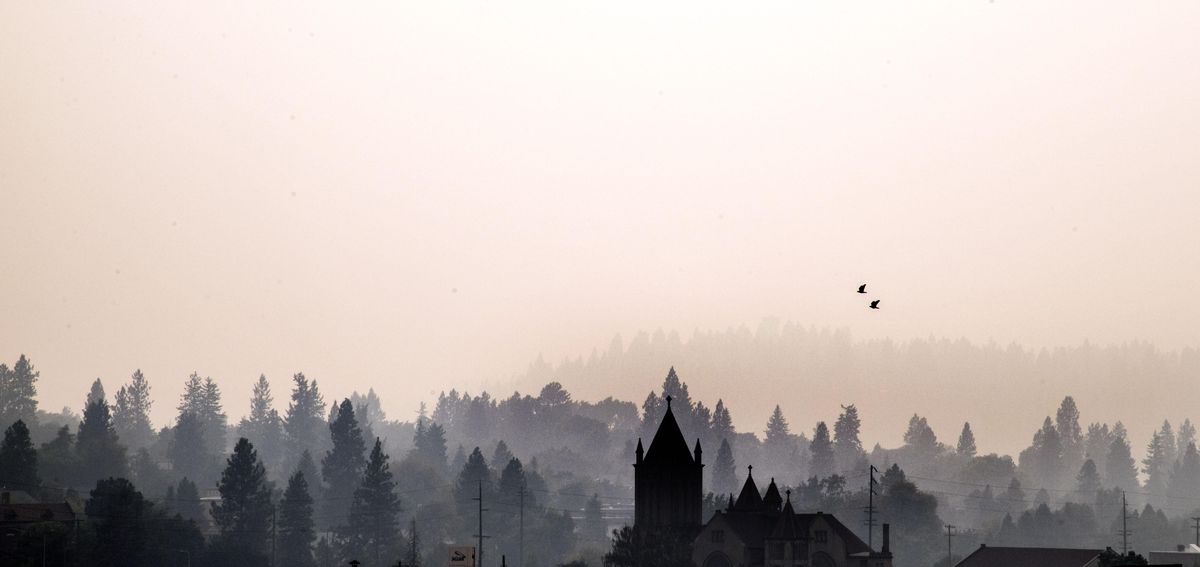Air in Spokane hazardous as wildfire smoke fills city

The wildfire smoke blanketing Spokane is expected to linger – and perhaps worsen – through Wednesday as health officials warned residents to seek refuge inside during the waning days of summer.
The air quality deteriorated to hazardous Monday afternoon and will likely lead to cancellations of outdoor school sports practices, recess and other activities, according to school officials.
Air quality remained hazardous Tuesday morning.
The smoke chased campers and boaters home early from their Labor Day trips as visibility shrunk to less than a mile on the region’s larger lakes. And lines for the season’s last day at Silverwood’s popular Boulder Beach water park slides and rides were short during the heat of the afternoon.
The National Weather Service forecast said the air quality will get even worse as “wind shifts bring in smoke from British Columbia and Montana, in addition to smoke from the Washington and Oregon Cascades.”
The air quality index was at 321 as of 7 p.m. Monday, according to the Washington Air Monitoring Network. It’s the worst hourly measure Spokane has seen since the index hit 330 in August 2015 during the state’s intense wildfire season.

Air quality indexes report the total amount of pollutants in the air on a 0-500 scale, with higher numbers meaning worse pollution.
Spokane’s Regional Clean Air Agency, which uses a 24-hour weighted average to measure air quality every hour, reported an index of 290 as of 7:15 p.m., putting air in the “very unhealthy” category. Both categories mean everyone can start to experience negative health effects from being outside.
North Idaho is faring worse, with an air quality index of 418 in Sandpoint, putting it well into the hazardous range. Levels in Coeur d’Alene were considered very unhealthy elsewhere with a measurement of 268. The two cities were among the worst in the nation for air pollution, according to the U.S. Environmental Protection Agency’s air monitoring tool.
Particulate matter can work its way into lungs, putting additional stress on respiratory and cardiac systems, said Dr. Bob Lutz, the Spokane Regional Health District’s health officer.
Bodies can filter some particulates out, but if they build up, they can start to clog the parts of lungs that help exchange oxygen in the blood. Lutz compared it to a filter full of soot.
“It just embeds itself,” he said.
When levels are lower, particulate matter is mostly a concern for people with diseases like asthma or chronic obstructive pulmonary disease. But at levels like these, particulates can injure even healthy lungs from too much exposure.
“It’s a cumulative effect, so the longer you’re out here, the more you’re breathing in,” Lutz said.
With pollution so bad, the Spokane Regional Health District recommends canceling all outdoor athletic activities.
Spokane Public Schools has sent principals and administrators at every school the guidelines from the health district, with instructions to check air quality hourly on Tuesday, said Kevin Morrison, the district’s spokesman. If air quality levels remain poor, principals will cancel gym classes, recess and other outdoor events as needed.
Planned field trips Tuesday may be canceled and rescheduled as well if air quality doesn’t improve.
“We will keep students inside without hesitation if it’s necessary,” Morrison said.
Regardless of Tuesday’s air quality, parents who would prefer their children be kept inside can call the school and ask, Morrison said.
Providence Health System has seen a few adults come into local emergency rooms with breathing problems likely caused or exacerbated by the smoke, Providence spokeswoman Liz DeRuyter said.
Emergency room staff have received some calls from parents who are concerned.
Smoke is blowing into the area from the northwest, southwest, and northeast, carrying poor air from fires in Montana, British Columbia, Idaho and Western Washington, the National Weather Service said.
At midnight, the air agency uses hourly reports from the previous day to determine an air pollution measure for the day as a whole. Even during the 2015 wildfire season, the daily average never dipped below “unhealthy,” the third-worst category. The agency has recorded zero days in the very unhealthy or hazardous range since 2013.
Monday morning was relatively clear, so it’s too early to tell what the history books will say about Labor Day 2017.
“Today may end up being a red ‘unhealthy’ day when you look at midnight to midnight,” said Lisa Woodard, a spokeswoman for the clean air agency.
Health district spokeswoman Kim Papich said some people have called asking about wearing respirators to aid breathing. There’s no official recommendation one way or another, but people should be aware respirators will only filter out particulate matter, not toxic gases or other chemicals in the air.
Particulate matter is the main pollutant in the air currently, according to the clean air agency.
Masks can also make breathing harder, which isn’t ideal for people with asthma or other conditions that making breathing more difficult.
Athletes who want to exercise outside should know their limits and be conscious of their time outside, Papich said.
“Cardiovascular exercise increases the amount of oxygen you need,” she said. “You’re increasing your chances of putting yourself at risk.”
In general, the safest thing to do it to stay inside.
“People should use their best judgment, especially people we know have a harder time with this air quality,” Papich said.
This article has been updated to add Kim Papich’s full name and title.
